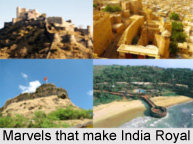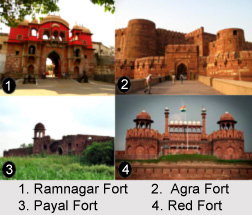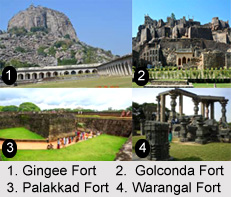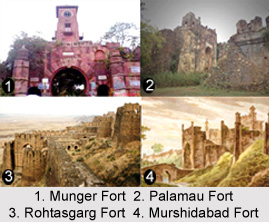 Forts in India have been constructed to protect the settlements against hostile attack and marauding wild animals. Due to successive waves of invasion, there was an ancient tradition in India to erect massive and strong forts to obstruct the invaders. The origins of some of the Indian forts are lost in the mists of time while some have been transformed or reconstructed after the invasion of the Muslims in the twelfth century.
Forts in India have been constructed to protect the settlements against hostile attack and marauding wild animals. Due to successive waves of invasion, there was an ancient tradition in India to erect massive and strong forts to obstruct the invaders. The origins of some of the Indian forts are lost in the mists of time while some have been transformed or reconstructed after the invasion of the Muslims in the twelfth century.
Early History of Forts in India
The ancient treatises on Indian architecture and fortification can be retrieved from the `Shilpa Shastras` and in some of the ancient Indian literature like the Indian Puranas and epics. This vast pool of knowledge gives a significant account of the development of the forts in India. `Pur`, a word which is mentioned repeatedly in the Vedas, means a rampart, fort or stronghold. Kautilya, in the forth century BC, wrote extensively regarding the protective fortifications. He differentiated forts as per the preferred types of site. The Nara Durg, a fort which was protected by men, gives an account of the Aryans correlation of a fort with a town.
 Medieval History of Forts in India
Medieval History of Forts in India
After the invasion of the Muslims, construction of forts in India reflects many of the developments which took place in Europe. The central citadel was kept isolated and secure from the expansive outwork of curtain walls. Usually the citadel was sited on a naturally defensible outcrop of rock. The forts of the great Maratha Emperors of western India like the Purandhar, Raigarh and Sinhagarh have manipulated natural terrain to their strategic advantage. At Gulbarga, in Deccan, the central stronghold followed the practice of the Crusader castles of the Near East, with a robust donjon or inner redoubt at the heart of the defence.
Forts of Northern India
Forts of Northern India consists of numerous forts like Akhnoor Fort, Ramnagar Fort and Khurnak Fort in Jammu and Kashmir, Fort at Bathinda, Payal Fort, Keshgarh Fort and Quila Mubarak in Punjab, Agra Fort, Aligarh Fort, Chunar Fort located in Mirzapur, Jhansi Fort, Ramnagar Fort, Sasni Fort, Hathras Fort in Uttar Pradesh and Pithoragarh Fort in Uttarakhand are a few of the renowned forts of this portion of the country. The Red Fort in Delhi which was constructed by the Mughal emperor Shah Jahan is an important historical fort.
 Forts of Southern India
Forts of Southern India
Tamil Nadu`s Alamparai Fort, Geldria Fort, Ginjee Fort, Erode Fort, Dingigul Fort, Droog Fort, Krishnagiri Fort, Kerala`s Bekal Fort, Chandragiri fort, Palakkad Fort, Pallipuram Fort and Adoni Fort, Bhuvanagiri Fort, Kondavid Fort, Gandikota Fort, Golkonda Fort, Devarakonda Fort, Khammam Fort, Warangal Fort, Medak Fort and other forts of Andhra Pradesh are worth mentioning.
Forts of Western India
Rajasthan is a unique place which shelters some of the most spectacular forts in the country. Amber Fort, Chittorgarh Fort, Jaisalmer Fort, Junagarh Fort, Kumbhalgarh Fort, Jaigarh Fort, Kota Fort, Lohagarh Fort, Taragarh Fort, Nahargarh Fort and many more. The other forts of Western India include the innumerable forts located in Mahasrastra which are Ahmednagar Fort, Arnala Fort, Alang Fort, Balapur Fort, Bandra Fort, Bombay Fort, Chanderi Fort, Jaigad Fort, Karnala Fort, Laling Fort, Mahim Fort, Sewri Fort, Versova Fort, Worli Fort, Vasai Fort, Udgir Fort, Torna Fort and numerable others. Goa`s Aguada Fort, Chapora Fort, Terekhol Fort and Puducherry`s French Fort Louis are the other interesting forts located here.
Forts of Eastern India
 The Eastern Indian state of West Bengal, Jharkhand and Bihar possess some incredible forts. The Fort of Murshidabad, Douse Fort and Fort William of West Bengal, Palamu Fort of Jharkhand and Jalalgarh Fort, Munger Fort, Bihar Dev Killa, Rohtasgarg Fort and Raj Darbhanga of Bihar are amongst the noted forts of East India.
The Eastern Indian state of West Bengal, Jharkhand and Bihar possess some incredible forts. The Fort of Murshidabad, Douse Fort and Fort William of West Bengal, Palamu Fort of Jharkhand and Jalalgarh Fort, Munger Fort, Bihar Dev Killa, Rohtasgarg Fort and Raj Darbhanga of Bihar are amongst the noted forts of East India.
Forts of Central India
Gwalior Fort, Bandhavgarh Fort, Mandav Fort, Raja Nal Fort, Gohad Fort, Ahilya Fort, Madan Mahal Fort at Jabalpur are some of the beautiful forts which are based in Madhya Pradesh, Central India.
With the use of artillery in warfare, the entire nature of forts in India changed. High, thick walls were replaced by broad, low, sunken ramparts, saved by ditches to provide a minimal target for cannon fire. With the sophistication of fire arms, massive angular, battered bastions with interlocking fields of crossfire substituted the curvilinear forms of the mediaeval strongholds. With the European influence, the great fortresses of the Portuguese at Diu and Goa, or the English at Fort St George, Chennai, or Fort William, in Kolkata, were formed on European principles, but adapted to an Indian context.



















